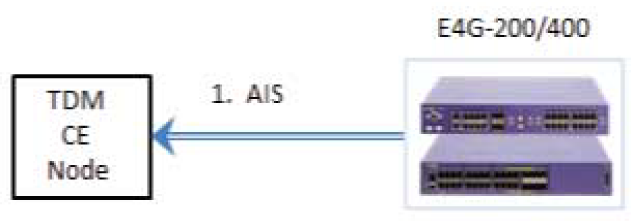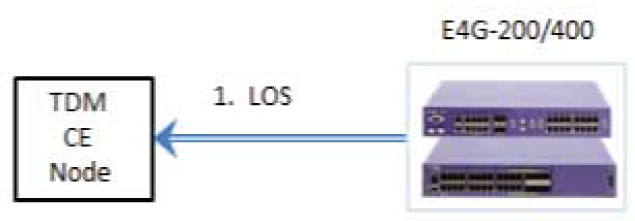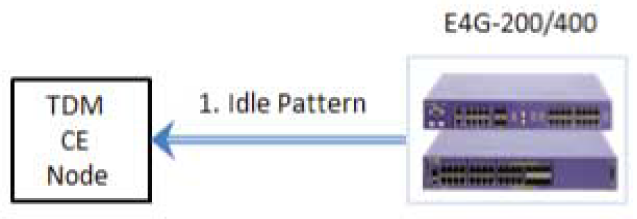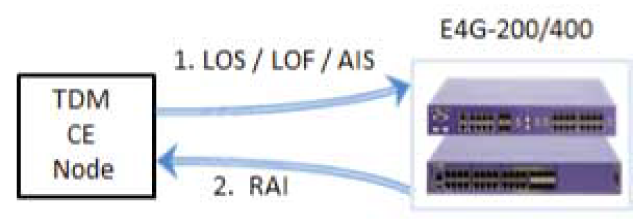The alarm events from the TDM port that are detected and the alarm response transmitted on the TDM port are listed in the following section.
The alarm response on the TDM port/time-slot(s) depends on the port or time-slot(s) configuration state. The port or time-slot is said to be in disconnected or in idle configuration state when they are not added to a TDM service. The port or time-slot(s) are said to be connected if they are part of a TDM service. In idle state, depending on the framing configuration on the port, the alarm response would vary. The alarms generated and the alarm events detected are logged.
AIS Alarm Generation
The TDM ports generate an Alarm Indication Signal (AIS) alarm by default on the ports that are not connected to a service. On ports that are connected to a service, the AIS alarm is generated to indicate pseudowire faults.

E4G switches do not detect AIS alarm events in unframed mode of operation.
LOS Alarm Generation
The TDM ports generate Loss of Signal (LOS) alarm on the ports that are administratively disabled. The alarm is cleared when the port is enabled.

LOS Alarm Response
The TDM ports detect a Loss of Signal alarm event. No specific data is played out as a response for this alarm event. However, when the port is not a part of TDM service, the preset idle pattern of all ones (or AIS) is played out. If the port is connected to a TDM service bound to a CES pseudowire, the TDM data from the remote end of the CES pseudo-wire, is played out, facilitating the tunneling of alarm event response from the remote TDM CE node.

Default Line State
The TDM ports send out a preset idle pattern of 0xFF on all timeslot(s) that carry TDM data. If signaling multiframe is configured on the TDM port (mf in E1 hierarchy and d4 or esf in T1 hierarchy), a configurable idle code is played out on the signaling channel/bits.

However, the idle pattern is not played out on certain special timeslots, as listed in the following table below.
Idle Pattern on Timeslots
| E1 Hierarchy | |
| Timeslot - 1 | Carries frame alignment signal, CRC and remote alarm information. |
| Timeslot - 16 (in frame 1/16) | Carries signaling multiframe alignment signal, spare bits and multiframe alarms. Applicable only if port handles signaling multiframe. |
| T1 Hierarchy | |
| F-bits | Carries framing alignment signal information. In case of Extended Super Frame formats, carries data link and CRC-6 information. |
Note that the idle pattern playout does not indicate the presence or generation of alarms and is presented here for information purposes.
LOS/LOF/AIS Alarm Response

Framing Types
| Hierarchy | Framing in E4G node | Framing in Remote CE node |
|---|---|---|
|
E1 |
Basic |
Unframed |
|
Signaling multiframe |
Unframed Basic |
|
|
CRC4 enabled |
CRC4 disabled |
|
|
T1 |
Super frame (D4) |
Unframed Extended super frame (ESF) |
|
Extended super frame (ESF) |
Unframed Super frame (D4) |
LOS Alarm Generation
The TDM ports generate Loss of Signal alarm on the ports that are administratively disabled. The alarm is cleared when the port is enabled.


 Print
this page
Print
this page Email this topic
Email this topic Feedback
Feedback